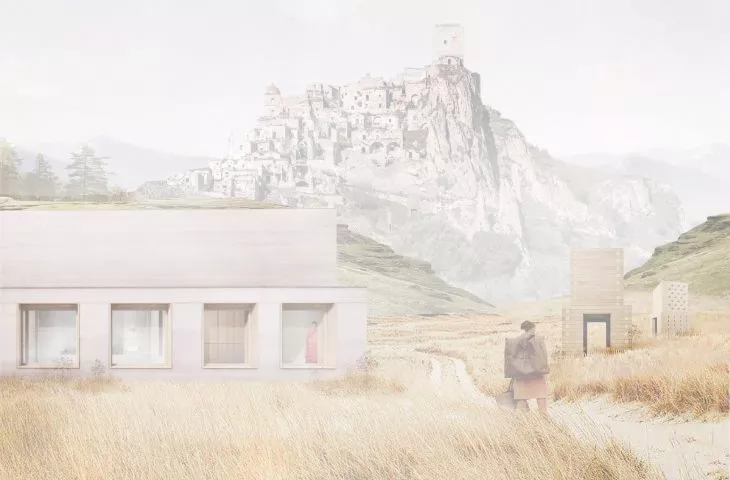Architects Martyna Dryś and Kinga Rzeplinśka decided to take up the theme of the abandoned Italian town of Craco, but instead of interfering with the fabric, they proposed objects to observe its slow disappearance and the passing of time. Their project made it to the finals of the Ghost Town Refuge competition .
Ghost Town Refuge is a competition organized by the YAC platform and Craco Ricerche. The task was to design a distributed system of contemporary shelters placed amidst the ruins of the ancient Italian city of Craco. The project was to allow visitors to spend the night under a starry sky amid the remains and sounds of the ancient, abandoned city.
The architects left the ruins of the city intact, proposing all the facilities on its outskirts
© Martyna Dryś, Kinga Rzeplińska
ghost towns
No story in reality ever ends [...], each is just a part of a larger story and is made up of told and silenced smaller stories. And in each of them, whether one wants to or not, all the shadows of others are also told wordlessly.
Builder of Ruins, Herbert Rosendorfer
Unwanted, unforeseen, unplanned. Ghost cities are structures that came into existence without purpose or sense. They are the result of ill-considered decisions, the consequence of a lack of strategy. The authors, full of respect for the existing ruins of Craco, proposed not to interfere in any way with the fabric of the city. They left the Italian town intact, while interpreting it as a mnemotopos - a topographical text of cultural memory, a point of crystallization of past events and values. They made it a treasure trove of traces of something that is no longer there, a place of absence.
The new buildings are a reinterpretation of the functional layout of the ancient house
© Martyna Dryś, Kinga Rzeplińska
As the authors state:
Craco as an urban structure should be given back to nature. Over the following years, the city would decay, gradually overgrown. We would be left only to take pleasure in observing the process of its decay. For those observing the disappearing city, we are creating opportunities for contemplation in wooden solitary houses and houses with cirlocks, along with a public visitor center. The proposed architecture does not interfere with the existing urban fabric, settling on its periphery, intervening only in three, precisely defined by us, places.
The new buildings do not interfere with the fabric of the city
© Martyna Dryś, Kinga Rzeplińska
out of respect for history
Thehistory of the city is told by the materials remaining on the site - compacted earth, the ruins of past architecture from hundreds of years ago, local wood. The architects proposed references to the observed threads that make up Craco's identity. These include compositions of split stone walls, faults in buildings, and foundation rocks stratified into individual outcrops. Distant from each other (temporally, thematically, formally), the materials become a new, multi-layered whole, creating an architecture outside of time, affecting a mood of seclusion and concentration.
The proposed architecture continues the history of the place, does not resurrect an artificially abandoned structure, respectfully distances itself from the ghost town and looks at it from a distance, the authors explain.
wooden alone
The basic proposed residential units are wooden solitudes. Located on the northeastern slope, they continue the rhythm set by the gradually stratifying rock. Together with the formation of three rocky outcrops, they form a composition of free-standing light points. Set on a stone foundation, they have been threaded into a viewing axis between Craco and the landscape. The open, public first floor provides shelter while wandering, the perforated walls allow framing of the city. The solitary floor is an isolated room with a skylight, allowing for contemplation and relaxation.
The wooden solitude allows for tranquility and contemplation
© Martyna Dryś, Kinga Rzeplińska
settlement of houses and tourist center
The second intervention introduced by the authors is a settlement of houses with cottages. The buildings clustered around inner courtyards are a reinterpretation of the functional layout of the ancient house. A living area with view openings, a courtyard in the form of a viridarium and an open spa area, a continuation of the culture of ancient baths, are envisioned. The final intervention in the stagnant urban fabric is the proposal of a new gateway - the Craco tourist center. Situated on the outskirts of the center, it serves as a landmark for visitors, isolating them from the historic fabric, allowing them to prepare for their visit. It draws tourists' attention to the sky, the surrounding nature and encourages them to listen to the voices of the abandoned city.
The visitor center located on the outskirts is a landmark
© Martyna Dryś, Kinga Rzeplińska
Craco does not necessarily last in material form. We tell the story in references, materials, buildings, which can be read like a casket novel. We have moved away from the narrative of a monolithic city, an ancient structure that must be artificially revalued. We postulate leaving the city in the form of decay, ruin, constant memory. As decay is noticed, stories of a more modest scope come to the fore - private stories, hitherto drowned out, denied seriousness. The intention of the project is to create a place without time, allowing solitude to be tamed. After all, we unnecessarily delude ourselves that we share reality with someone other than ourselves," conclude Martyna Dryś and Kinga Rzeplińska.
Read also about the space project, the basis for Syria's cultural revival.






















































